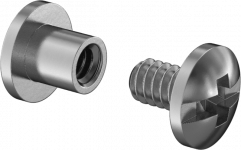aCircle
Member
- Joined
- Nov 24, 2020
- Messages
- 46
I'm helping my dad build a container to get animal bones cleaned.
As part of that, I need to cut parts of a few drums I picked up and attach some hardware cloth. I'm thinking a cutoff wheel should be fine for cutting the drum.
Where I'm wondering is about the screws or fasteners for attaching the hardware cloth. Panhead metal screws would leave sharp tips on the inside of the drum. Pre-drill and use small stainless bolts?
Curious what you all might recommend for hardware or process here!
As part of that, I need to cut parts of a few drums I picked up and attach some hardware cloth. I'm thinking a cutoff wheel should be fine for cutting the drum.
Where I'm wondering is about the screws or fasteners for attaching the hardware cloth. Panhead metal screws would leave sharp tips on the inside of the drum. Pre-drill and use small stainless bolts?
Curious what you all might recommend for hardware or process here!



